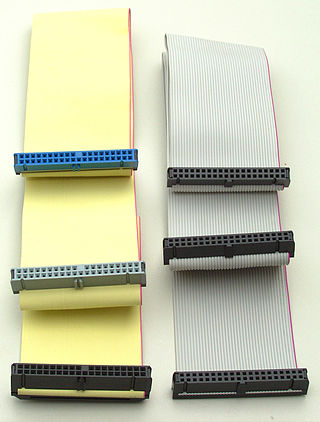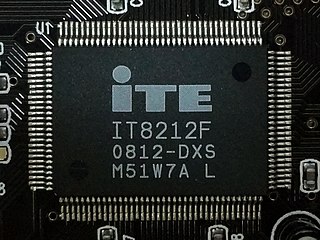
Parallel ATA (PATA), originally AT Attachment, also known as Integrated Drive Electronics (IDE), is a standard interface designed for IBM PC-compatible computers. It was first developed by Western Digital and Compaq in 1986 for compatible hard drives and CD or DVD drives. The connection is used for storage devices such as hard disk drives, floppy disk drives, optical disc drives, and tape drives in computers.

The Ultra DMA modes were the fastest method used to transfer data through the ATA hard disk interface, usually between the computer and an ATA device. UDMA succeeded Single/Multiword DMA as the interface of choice between ATA devices and the computer. There are eight different UDMA modes, ranging from 0 to 6 for ATA, each with its own timing.

SATA is a computer bus interface that connects host bus adapters to mass storage devices such as hard disk drives, optical drives, and solid-state drives. Serial ATA succeeded the earlier Parallel ATA (PATA) standard to become the predominant interface for storage devices.
The Filesystem Hierarchy Standard (FHS) is a reference describing the conventions used for the layout of Unix-like systems. It has been made popular by its use in Linux distributions, but it is used by other Unix-like systems as well. It is maintained by the Linux Foundation. The latest version is 3.0, released on 3 June 2015.
Logical block addressing (LBA) is a common scheme used for specifying the location of blocks of data stored on computer storage devices, generally secondary storage systems such as hard disk drives. LBA is a particularly simple linear addressing scheme; blocks are located by an integer index, with the first block being LBA 0, the second LBA 1, and so on.
A disk array controller is a device that manages the physical disk drives and presents them to the computer as logical units. It almost always implements hardware RAID, thus it is sometimes referred to as RAID controller. It also often provides additional disk cache.

Self-Monitoring, Analysis, and Reporting Technology is a monitoring system included in computer hard disk drives (HDDs) and solid-state drives (SSDs). Its a primary function is to detect and report various indicators of drive reliability, or how long a drive can function while anticipating imminent hardware failures.

The USB mass storage device class is a set of computing communications protocols, specifically a USB Device Class, defined by the USB Implementers Forum that makes a USB device accessible to a host computing device and enables file transfers between the host and the USB device. To a host, the USB device acts as an external hard drive; the protocol set interfaces with a number of storage devices.

The SRM firmware is the boot firmware written by Digital Equipment Corporation (DEC) for computer systems based on the DEC Alpha microprocessor. SRM are the initials of (Alpha) System Reference Manual, the publication detailing the Alpha AXP architecture and which specified various features of the SRM firmware.
Automatic acoustic management (AAM) is a method for reducing acoustic emanations in AT Attachment (ATA) mass storage devices for computer data storage, such as ATA hard disk drives and ATAPI optical disc drives. AAM is an optional feature set for ATA/ATAPI devices; when a device supports AAM, the acoustic management parameters are adjustable through a software or firmware user interface.

PulseAudio is a network-capable sound server program distributed via the freedesktop.org project. It runs mainly on Linux, including Windows Subsystem for Linux on Microsoft Windows and Termux on Android; various BSD distributions such as FreeBSD, OpenBSD, and macOS; as well as Illumos distributions and the Solaris operating system. It serves as a middleware in between applications and hardware and handles raw PCM audio streams.

The IT8212, or more correctly the IT8212F, is a low-end Parallel ATA controller designed by ITE Tech. Depending on the implemented BIOS and configuration the IT8212F functions in either a RAID or an ATAPI mode, supporting up to four devices using dual channels. The raid mode only supports IDE Hard Disk Drives and includes RAID 0, RAID 1, Raid 0+1 and JBOD, along with a "normal" mode that essentially acts as a standard Hard Disk controller. Optical disk drives such as CD-ROM and DVD drives are supported by the ATAPI mode, which also supports Hard Disk Drives at the loss of all RAID functions. RAID functions are implemented by an embedded microprocessor, thus is not a so-called "Soft raid" controller.
In computing, error recovery control (ERC) is a feature of hard disks which allow a system administrator to configure the amount of time a drive's firmware is allowed to spend recovering from a read or write error. Limiting the recovery time allows for improved error handling in hardware or software RAID environments. In some cases, there is a conflict as to whether error handling should be undertaken by the hard drive or by the RAID implementation, which leads to drives being marked as unusable and significant performance degradation, when this could otherwise have been avoided.

Fiwix is an operating system kernel based on the UNIX architecture and fully focused on being POSIX compatible. It is designed and developed mainly as a hobbyist operating system, but it also serves for educational purposes. It runs on the i386 hardware platform and is compatible with a good base of existing GNU applications. It follows the UNIX System V application binary interface and is also mostly Linux 2.0 system call ABI compatible.
In Unix-like operating systems, a device file, device node, or special file is an interface to a device driver that appears in a file system as if it were an ordinary file. There are also special files in DOS, OS/2, and Windows. These special files allow an application program to interact with a device by using its device driver via standard input/output system calls. Using standard system calls simplifies many programming tasks, and leads to consistent user-space I/O mechanisms regardless of device features and functions.
SCSI / ATA Translation (SAT) is a set of standards developed by the T10 subcommittee, defining how to communicate with ATA devices through a SCSI application layer. The standard attempts to be consistent with the SCSI architectural model, the SCSI Primary Commands, and the SCSI Block Commands standards.
A trim command allows an operating system to inform a solid-state drive (SSD) which blocks of data are no longer considered to be "in use" and therefore can be erased internally.

ATAPI is a protocol used with the Parallel ATA (IDE) and Serial ATA standards so that a greater variety of devices can be connected to a computer than with the ATA command set alone. It carries SCSI commands and responses through the ATA interface.

Dracut is a set of tools that provide enhanced functionality for automating the Linux boot process. The tool named dracut is used to create a Linux boot image (initramfs) by copying tools and files from an installed system and combining it with the Dracut framework, which is usually found in /usr/lib/dracut/modules.d.









